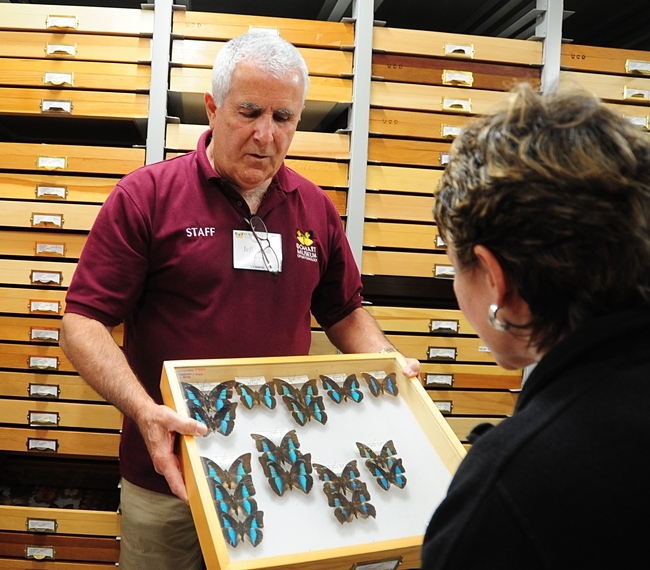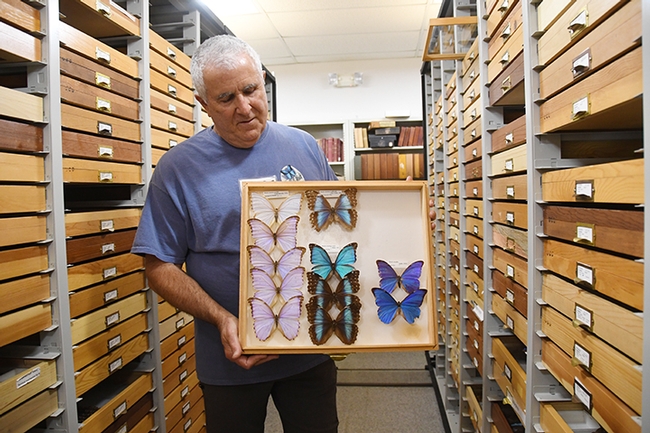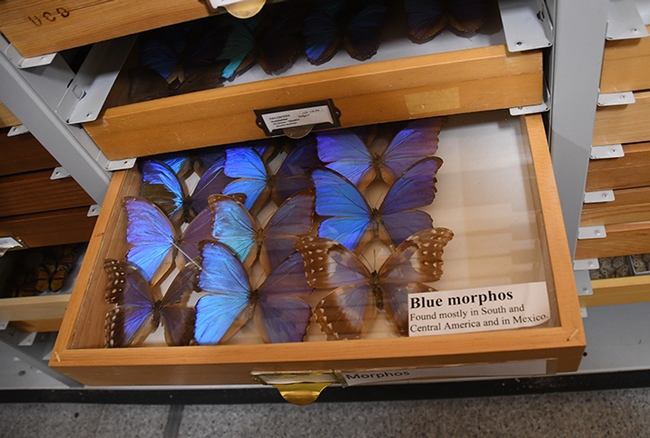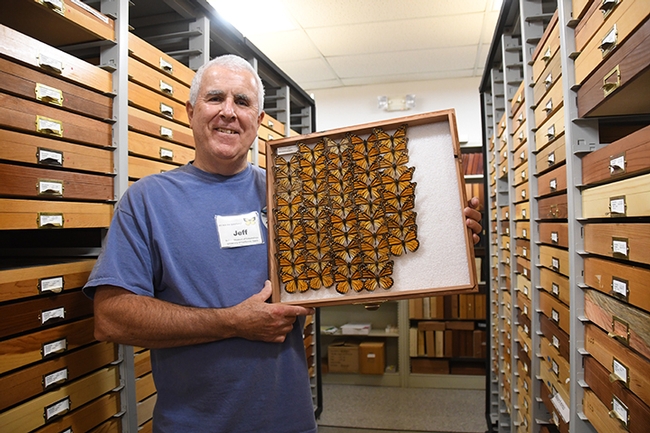
Entomologist Jeff Smith, who curates the Lepidoptera (butterflies and moths) collection, says "I believe we have half a million Lepidoptera in our collection, and it is likely 60 percent moths and 40 percent butterflies."
What can visitors expect to see at the Bohart Museum during the four-hour open house from 9 to 1 p.m. on Biodiversity Museum Day? The Bohart will be one of 13 museums or collections open to the public and the event if free and family friendly.
"They will see thousands of species of butterflies--and maybe moths if we open those aisles as well--that they have never seen before," Smith says. "They can learn about the defensive strategies these insects use for survival, such as camouflage, warning coloration, mimicry of other species. We love to teach about the importance of Lepidoptera in the environment, either to their habitat directly or possibly as an indicator of the health of their habitat. And, of course, they can be amazed at the beauty of these insects."
This is truly a global collection.
"We have specimens from all over the world, from every continent," Smith notes. "We are especially strong, of course, in North American material but also strong in Central and South America, and these areas represent much of our continuing growth. We have a great deal of material from Papua New Guinea, Australia, Indonesia, Malaysia, Taiwan, and other eastern Asian countries. We have a great amount of material from Africa, particularly Zambia and Democratic Republic of the Congo. We are especially strong with northern Mexico moths, much of which likely represents species still undescribed by taxonomists."
Are endangered or threatened butterflies in the collection? Yes.
"We do have examples of most of the threatened and endangered species of butterflies, and even examples of some of the butterfly species now extinct (due to destruction of habitat by urbanization). Due to wonderful donations over the decades we have examples of very rare species from Asia and Africa, as well as a growing collection of the extraordinary Birdwing Butterflies from the Indonesian-Australian region."
The Bohart's monarch butterfly specimens comprise five drawers and they include specimens from the Pacific Islands, Australia and Eastern Asia, as well as the United States.
"Without a doubt, the biggest 'Wow Factor' comes from the huge and brilliant metallic blue Morpho butterflies from tropical America," Smith points out. "We also have four drawers of the Atlas moths from Asia, the largest insects in the world. We have specimens of the White Witch moth, with the widest wingspan of any Lepidoptera. We have many drawers of Asian swallowtails that are brilliant metallic blue and green, as well as the striking Birdwing Butterflies that are green, blue, gold, and HUGE."
Smith himself has collected many of them. "I have not kept track, but I have been passionate about Lepidoptera since 1967, have made 12 research trips to Latin America, and probably have collected 50,000 to 60,000 specimens myself, all of which reside in the Bohart collection."
Does he have a favorite?
"Oddly, my favorite group of butterflies may be the Arctics (genus Oeneis), which occur throughout the western United States, Canada, and to Alaska. I like them due to their habitat, normally, of high mountain areas, and they remind me of the thrill I feel when hiking in these areas. My favorite moths could be the wasp-mimics in the Arctiid moths, the subfamily Ctenuchinae. Hundreds of different species are found in the Neo-Tropics and their amazing colors and often strong resemblance to wasps intrigues me."
Smith, a resident of Rocklin, received a 2015 “Friend of the College” award from the UC Davis College of Agricultural and Environmental Sciences for his volunteer work, including preparing specimens and organizing the collection. At the time he had spread the wings of more than 200,000 butterflies and moths, amounting to 33,000 hours of volunteer service.
Today it's many more. Many, many more.
“Entomology is my passion," he says, "and the Bohart Museum is my cause.”
Lynn Kimsey, director of the Bohart Museum and UC Davis professor of entomology, who nominated Smith for the award, praised him for completely reorganizing the butterfly and moth collection. “It's no small feat to rearrange this many specimens, housed in roughly one thousand drawers,” she said. “Many thousands of the specimens needed to be identified, and the taxonomy required extensive updating and reorganization.”
In her nomination letter, she wrote that “You could not ask for a better friend than Jeff Smith. He has brought us international acclaim and saved us $160,000 through donations of specimens and materials, identification skills and his professional woodworking skills. This does not include the thousands of hours he has donated in outreach programs that draw attention to the museum, the college and the university.”
Kimsey, who has directed the museum since 1989, remembers when Smith joined the museum. “When Jeff was working for Univar Environmental Services, a 35-year career until his retirement in 2013, he would spend some of his vacation days at the museum. Over the years Jeff took over more and more of the curation of the butterfly and moth collection. He took home literally thousands of field pinned specimens and spread their wings at home, bringing them back to the museum perfectly mounted."
The Bohart Museum houses a global collection of nearly eight million specimens. It is also the home of the seventh largest insect collection in North America, and the California Insect Survey, a storehouse of the insect biodiversity. Noted entomologist Richard M. Bohart (1913-2007) founded the museum.
Special attractions include a “live” petting zoo, featuring Madagascar hissing cockroaches, walking sticks and tarantulas. Visitors are invited to hold the insects and photograph them. The museum's gift shop, open year around, includes T-shirts, sweatshirts, books, jewelry, posters, insect-collecting equipment and insect-themed candy.
The Bohart Museum's regular hours are from 9 a.m. to noon and 1 to 5 p.m. Mondays through Thursdays. The museum is closed to the public on Fridays and on major holidays. Admission is free. Open houses, focusing on specific themes, are held on weekends throughout the academic year. More information on the Bohart Museum is available by contacting (530) 752-0493 or Tabatha Yang, education and public outreach coordinator at tabyang@ucdavis.edu
UC Davis Biodiversity Museum Day
The UC Davis Biodiversity Museum Day, always held the Saturday of Presidents' Day weekend, is billed as a “free, educational event for the community where visitors get to meet and talk with UC Davis scientists from undergraduate students to staff to emeritus professors and see amazing objects and organisms from the world around us.” Parking is also free. Maps are available on the Biodiversity Museum Day website at http://biodiversitymuseumday.ucdavis.edu/.
These seven collections will be open from 9 a.m. to 1 p.m.:
- Arboretum and Public Garden, Good Life Garden, next to the Robert Mondavi Institute, 392 Old Davis Road, on campus
- Bohart Museum of Entomology, Room 1124 of the Academic Surge Building, Crocker Lane
- California Raptor Center, 340 Equine Lane, off Old Davis Road
- Museum of Wildlife and Fish Biology, Room 1394, Academic Surge Building, Crocker Lane
- Paleontology Collection, Earth and Physical Sciences Building, 434 LaRue Road
- Phaff Yeast Culture Collection, Robert Mondavi Institute of Wine and Food Science, 392 Old Davis Road, on campus
- Viticulture and Enology Culture Collection, Robert Mondavi Institute of Wine and Food Science, 392 Old Davis Road, on campus
The following will be open from noon to 4 p.m.:
- Anthropology Museum, 328 Young Hall and grounds
- Botanical Conservatory, Greenhouses along Kleiber Hall Drive
- Center for Plant Diversity, Sciences Laboratory Building, off Kleiber Hall Drive
- Häagen-Dazs Honey Bee Haven, Bee Biology Road, off Hopkins Road (take West Hutchison Drive to Hopkins)
- Nematode Collection, Sciences Laboratory Building, off Kleiber Hall Drive
- Marine Invertebrate Collection, Sciences Laboratory Building, off Kleiber Hall Drive
Attached Images:

Entomologist Jeff Smith, who curates the Lepidoptera collection at the Bohart Museum, holds some of the Morpho specimens. (Photo by Kathy Keatley Garvey)

Blue morpho butterflies are among the "Wow" displays at the Bohart Museum of Entomology. (Photo by Kathy Keatley Garvey)

The Bohart Museum has five drawers of monarch butterfly specimens. Here curator Jeff Smith shows some of them. (Photo by Kathy Keatley Garvey)